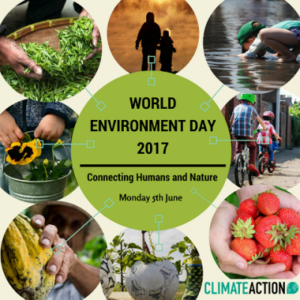
Environmentalists and academics bitter-sweet on sugar cane cultivation in Bibile
By Chrishanthi Christopher
The Government plan to launch a sugar company in Bibile has drawn protests from environmentalists who say that, the cultivation of sugarcane will use up the ground water, depriving people of their source of legitimate drinking water. A Cabinet paper has reportedly been passed for the project due to commence in early December. Under the project, plans are under way to distribute 62,500 acres of land to 10,000 farmers in the Uva-Wellassa region, to cultivate sugarcane in the area.

Residents hold a protest
Under the scheme, each farmer will get 2.5 hectares of land to cultivate sugarcane. It is claimed the project will eliminate poverty among farmers in the area. The Centre for Environment and Nature Studies claimed the Govt has given a human face to the project, following massive protests encountered in the past. Convener Raveendra Kariyawasam said an earlier attempt in 2006, by the then Govt to hand over the sugarcane project to Britain’s Booker Tate, was foiled by protesting people.
The farmers are expected to cultivate the land and sell the produce to the company. The land will be leased to the farmers, while farmers opting to withdraw from the project will have to return the land to the Govt. The company will be given only 149 acres of land on which to operate. Environmentalists fear that the cultivation of sugarcane will use up the ground water used by the area residents for drinking, as they claim that, sugarcane cultivation needs plenty of water hence, depleting the Uva-Wellessa water table.
Professor B. Marambe of the Peradeniya University’s, Agriculture Dept, said the crop does not use up ground water for growth. “Sugarcane belongs to the grass family, just like rice, maize and sorghum and, unlike rice, grows well in the highlands. Rice, on the other hand, is extensively cultivated in the lowlands and uses up plenty of water, while sugarcane, comparatively, uses less water,” he said. The Professor, who has done extensive research on sugarcane said the crop takes 9 to 12 months to yield, and needs continuous and adequate water right through the year and, because of its longer duration to yield, may use up more water. But, as the root system is fibrous, it cannot reach down to the ground water.
Further he discounted the argument that many sugar producing companies in the world are moving away from sugarcane cultivation because of the drain on ground water tables in those areas.
“They are moving out because of the agricultural chemicals used to kill the weeds in sugarcane cultivation,” he said. He maintains that, if a bi-annual crop is cultivated on the same land, the water usage will be very much higher. “It is only speculation that the water table will be exhausted. Sugarcane belongs to the C4 category of plants and uses up less water than the C3 category- maize and paddy plants.”
“In Moneragala, the ground water table is deep and the volume of water underground fluctuates according to the rainfall received in those areas,” he said.
Meanwhile, Director-CEO of the Sugar Research Institute, Dr A.P. Keerthipala also dismissed the argument that ground water will be depleted. “There is no scientific evidence to prove this,” he said.
“There is always opposition when a new project comes up. This project is designed to uplift the economic levels of the poor farmers who can earn up to Rs 250,000 a year. In addition, there will be several infrastructure developments which the residents of the area can enjoy,” he said. “Also, there are several other upcoming projects in Batticaloa, Maduru Oya and in the North,” he said.
Source – 04/06/2017,The Sunday Times, See more at – http://www.sundaytimes.lk/170604/news/environmentalists-and-academics-bitter-sweet-on-sugar-cane-cultivation-in-bibile-243445.html

Sampur pilot whales stranding will remain a mystery View(s): 132
A pod of about 20 pilot whales stranded on Sampur beach in Trincomalee were pushed back to sea last Wednesday by some navymen and locals.
Marine mammal expert Ranil Nanayakkara, identified them as short-finned pilot whales (Globicephala macrorhynchus).
While this is rare in Sri Lanka, there have been occasions elsewhere when pilot whales have run aground.
Mr Nanayakkara points out that in February more than 400 pilot whales washed up on a New Zealand beach.

The pod of about 20 pilot whales stranded on Sampur beach in Trincomalee
Beached whales die due to dehydration, or drowning when high tide covers the blowhole. In some cases, they die by collapsing under their own weight.
Available literature indicates that about 10 species of whales – mostly toothed whales are more prone to being stranded than others.
Why whales get beached in an apparent suicide mission remains a mystery. Many whales use echolocation to navigate, so one theory is that man-made sonar in ships etc. may be interfering with whales and/or natural brain wave activity causing them to become disoriented. Seismic activities on the ocean floor too could be contributory factor.
Most of the whales have close-knit family units, so another hypothesis is that a pod of whales can accidentally become stranded when attempting to come to the aid of a beached whale that is sending out distress calls.
A pilot whale pod can be made up of 20 to 50 individuals, but large super pods with hundreds of individuals too are frequent. They are primarily matrilineal or a female-based society with strong family bonds, so if one swims on to the beach, the others could follow. They have an acute sense of hearing according to marine researchers, making them more prone to stranding. In 1918, over 1,000 pilot whales got beached in New Zealand.
Although the pilot whale’s behaviour resembles that of larger whale species, it belongs to the oceanic dolphin family. Pilot whales are large, robust animals with a bulbous head and no discernible beak. They are black in colour. A male pilot whale can grow up to 5.5 metres (18 ft) in length, whereas adult females are about 3.7 metres (12 ft) in length.
The short-finned pilot whale primarily feeds on squid while certain species of fish and octopus too are included in their diet. They dive deep 300 metres (1000 ft) deep or more in search of prey and spend great lengths of time at depth. Pilot whales are also known as the ‘cheetas of the deep’ for their ability of high speed pursuit of prey deep in the ocean.
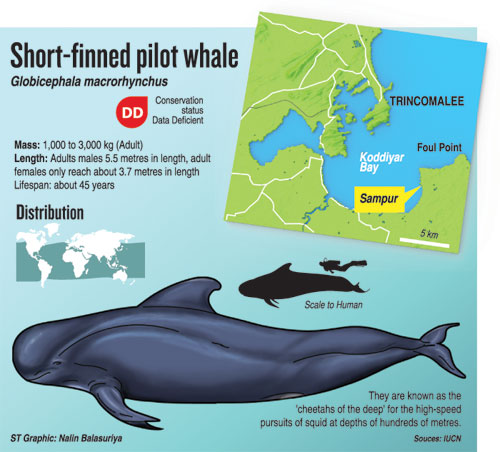
Source – 04 /06/2017, The Sunday Times, See more at – http://www.sundaytimes.lk/170604/news/sampur-pilot-whales-stranding-will-remain-a-mystery-243484.html

Muthurajawela becoming environmental wasteland
Dead Fish
Thousands of fish farmed for consumption have been found dead at Bopitiya, Muthurajawela after heavy rains and the flooding contaminated the farms with waste from large scale piggeries, factories, and the recently dumped garbage. The people who ran the fish farms say the fish were dead within days when dark oily water contaminated their tanks.
The Sunday Times journalists witnessed the dead and blackened fish that floated on the surface of the water.
One fish farmer, Sarath Saparamadu, estimated his losses at Rs 150,000. He is also the treasurer of the Pamunugama Jala Jeewi Wagakaruwange Sangamaya.
He explained that the fish farmers specialised in thilapia, which they sell to hotels. “I was hoping to collect the catch within two months, but lost everything. Usually I collect over 20 metric tonnes,’’ he said.
The villagers in the area said that Muthurajawela can no longer be called a marsh because of the farms, steel factories, and garbage dump sites.
Mr Saparamadu said that the public health inspector and Grama Sevaka had only visited his residence at Madawatta, Muthurajawela once. The official did not even collect water samples.
Fish farmer, Rukman Chandrasena, said he had once witnessed the deaths of fish earlier, when waste from a large scale pig farm contaminated the water. He had complained to the PHI, the Grama Sevaka, and the Pamunugama Police at the time, but it was futile.
Once again, he complained of the damage, a week ago, he said. But no one is taking responsibility and there is no compensation.
He said that most fish farmers use water from the Hamilton Canal and other small waterways which are connected to the Muthurajawela lagoon. He said the fish in the canal have disappeared.
“Our tanks fill up with contaminated water during high tide and flush out. In my seven tanks, 15,000 fish are under threat. Already three tanks have been affected,’’ he said.
After many complaints, the PHI and the Grama Sevaka visited the area but nothing was done.
Meanwhile, the president of the Pamunugama Jala Jeewi Wagakaruwange Sangamaya, N.T.A Perera, said that he lost between 12,000 and 20,000 fish.
He said the fingerlings died quickly. Only one tank out of four holding fingerlings remained unaffected.
Three fish farmers in Bopitiya, including himself, were affected, while 22 members of the group, operating in other areas, escaped the damage.
“Owners of the pig farm release waste into the water during the rainy season while factories also pump toxic waste into the water,” he said.
Anil Lankapura Jayamaha, the president of the Organisation for Protecting Muthurajawela Sanctuary, said he had predicted such incidents following garbage dumping in Muthurajawela.
The Bopitiya Police, Govijana Seva Centre, and the Wild Life Department are ignoring the environmental degradation, he said.
Mr Jayamaha said that the people also filed a fundamental rights case against the destruction of the environment.
He charged that supporters of the previous lands minister and other powerful people are filling up sites illegally.
A senior official of the Wattala Divisional Secretariat, said that the government is causing massive damage to Muthurajawela by dumping garbage there.
The PHI of Bopitiya S R K Indunil Samaratunga declined to comment when contacted.
Meanwhile, the Sunday Times has learned that trucks are dumping unsegregated garbage on the Bopitiya gas plant site.
The Colombo Municipal Commissioner V K Anura claimed that only segregated garbage is dumped at Bopitiya. Meat or fish waste are not taken to the site, he said.
He said local government bodiesfrom other areas dump unsegregated garbage on the site. “Our garbage dumping is done smoothly. There are no issues regarding [our] garbage,’’ he claimed.
But Colombo Municipal Council garbage truck drivers said the garbage is not sorted.
Sometimes they are not allowed to dump garbage at Bopitiya because it had not been separated, or because it exceeded the daily limits, they said.
“Our overtime allowance is cut if we dump unsegregated garbage,” they said.
They said senior officials keep changing their plans about garbage collection.
“We used to only collect separated garbage on some days and unsegregated garbage on other days. Now people give us all the garbage, unseparated. So we are compelled to dump it (in Bopitiya),” the truck drivers said.
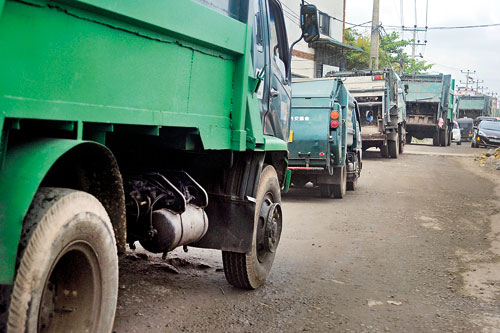
Trucks returning to Colombo after dumping unsegregated garbage at the site of the Bopitiya gas plant

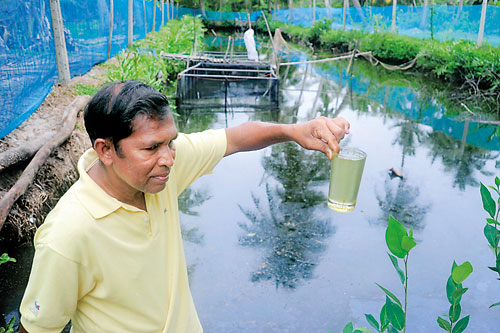
Sarath Saparamadu: Estimates his losses at Rs 150,000. Pix by Amila Gamage
Source – 04/06/2017, The Sunday Times, See more at – http://www.sundaytimes.lk/170604/news/muthurajawela-becoming-environmental-wasteland-243476.html

Yala National Park a mess due to political meddling
Give DWC independence to do its job, urges former DG
Tourism officials conspicuous absentees at biodiversity event
By Kumudini Hettiarachchi
Everyone else was there, except the tourism officials. Even though numerous invites had gone out to a wide-range of tourism officials, no one deemed it important to grace the discussions on ‘Biodiversity & Sustainable Tourism’ vital for people’s existence, held on May 22. This was what the participants at the event organised by Biodiversity Sri Lanka (BSL) on International Day for Biological Diversity held at the HNB auditorium in Colombo heard after queries were raised whether any tourism officials were present.

The panellists (from left) Dilhan Bandara from Tangalle’s Anantara Hotel, Madura de Silva of the Wildlife Conservation Society, Galle, Maeve Nightingale from the International Union for Conservation of Nature (IUCN) and Dr. Sumith Pilapitiya, former Director-General of the Department of Wildlife Conservation.
Four panellists dealt with the crucial topics of ‘Challenges in the Yala National Park (NP)’; ‘Vistas of Sinharaja’; ‘Dollars for deeds’; and ‘Significance of the coasts around us’, after which there was a robust discussion moderated by BSL Advisor Shiranee Yasaratne.
Tackling over-visitation and its consequences on the biodiversity of the Yala NP, former Director-General (DG) of the Department of Wildlife Conservation (DWC), Dr. Sumith Pilapitiya, questioned whether a natural ecosystem can sustain “abuse” in the light of tourist numbers skyrocketing more than 1,000% from 2008 to 2015 – from 48,368 to 545,007 visitors at Yala.
Explaining that no formal studies have been done whether over-visitation has adverse impacts on biodiversity, he pointed out that road-kills have increased within the Yala NP, there is harassment of wildlife at sightings, visitors are feeding wild animals and causing behavioural changes in them and there is anecdotal evidence of a decline in the animal population within Yala.
He was very critical of the government’s “over-emphasis” on tourism revenue, while neglecting protection and management of Protected Areas. Dr. Pilapitiya not only zeroed-in on the problems but also provided answers on how to overcome them. According to him the approach should be the identification of the issues that need to be addressed and the constraints in dealing with them; and studying the profile of tourists using Block 1 of the Yala NP where there are huge issues, while introducing a strategy to improve overall visitor experience there.
“The nature-interpretation services offered by the DWC are poor,” he said, adding that the DWC also faces a dearth of staff and facilities such as patrol vehicles to regulate tourism within the NP. The DWC is challenged by inadequate guide numbers, inability to get government approval for more recruitment, weak enforcement of NP rules and lack of independence to penalize violators.
While there are nearly 700 registered commercial safari vehicles, the issues to be addressed include the indiscipline of safari jeep drivers and passengers whenever there are animal sightings, high speed and reckless driving when attempting to reach such sightings and massive vehicle jams and disturbance of wildlife during sightings.

“If there is one paradise for leopards on earth, it has to be Yala National Park,” had said award-winning wildlife photographer Angela Scott but have Yala’s leopards been over-marketed?
The former DWC Director-General who resigned due to political interference preventing him from performing his duties, pointed without ambiguity, at “continued political interference” in the wake of which follows lack of independence for the DWC to regulate tourism within Yala. “There is uneven imposition of rules due to political patronage and interference.”
He also added that while Yala’s Block 1 faced much over-visitation, the wildlife in Blocks 3, 4 and 5 were not habituated to visitor-vehicles. Profiling the current ‘visitors’ to Yala, he said they are focusing on “sightings” and not “observations”, with the NP at present being marketed as a “leopard-sighting location”. Therefore, the short-term strategy for the conversion of Yala into a “wildlife observation site” is impractical.
Dr. Pilapitiya turns the spotlight on an implementable ‘Action Plan’ proposed, which includes:
- 31 short-term actions to be implemented by January 1, 2018 — Regular patrolling, strict enforcement of rules, progressively increasing penalties, speed-bumps, uni-flow system where possible, training of both safari jeep drivers and DWC guides and using Blocks 2, 3, 4 and 5 for ‘wilderness’ tourism.
- 9 medium-term actions to be implemented by January 1, 2019 – Zoning the park, opening the west-side of the Sithulpauwwa Road, a carrying-capacity assessment and halting the over-promotion of Yala by the tourism industry.
- 2 long-term actions by 2023 – With increased sightings in Blocks 3, 4 and 5, imposition of vehicle limits in all blocks through gradual reductions and empowerment of DWC officials.
Dr. Pilapitiya is adamant that DWC officials “must” be empowered to enforce regulations without being fearful of a political backlash. “For this, the responsibility clearly lies with the highest-level political authorities and the Wildlife Minister.”
Referring to the coast around us, it is Maeve Nightingale of the International Union for Conservation of Nature (IUCN) who details marine and coastal tourism that Sri Lanka can engage in, however, stressing that there is a fine balance between conceptual issues and constraints to sustainable tourism, when taking into account the environment (natural habitats and local livelihoods) on one hand and financial criteria (infrastructural development, tourist arrivals and tourism products and services) on the other.
She pointed out that tourism as a whole is the most international “trade” item with reef tourism becoming an increasingly large component. However, the adverse impacts of reef-based tourism could be immense.
Citing the example of the small island of Koh Tao in the Gulf of Thailand, Ms. Nightingale said that it has one of the largest dive industries in the world with over 65 dive schools and operators. It is also accountable for one-third of the annual registrations of the Professional Associations of Dive Instructors (PADI) internationally.
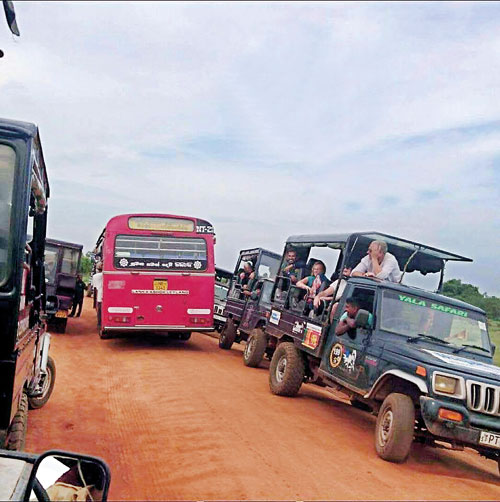
Jam-packed with vehicles – whose home is the Yala National Park?
According to her, Koh Tao’s management issues are wide-ranging – shortage of freshwater and groundwater; inadequate solid waste collection and disposal; untreated wastewater disposal from communities and tourist facilities; rapid unplanned development; construction and encroachment on beach and terrestrial forest; although building legislation and the requirement of environmental impact assessments (EIAs) are in place there is no consistent enforcement; tourist numbers exceeding the island’s carrying capacity; the uneven distribution of benefits from tourism; and the high cost of living for the local people.
The list goes on: High energy demands and dependency on diesel-fuelled generators; localized oil-spills from fishing and tourism boats; coral-reef degradation; decline in fisheries resources; and a development plan launched in 1995 but not well-adopted.
There are key factors to sustainably managing coastal tourism, says Ms. Nightingale. They are:
- Capacity development
- Consideration of a complex range of sub-national, national and transnational relationships
- Regulatory frameworks
- Community involvement, trust, acceptance and support
- Payment for Ecosystem Services (PES) – compensating for loss of earnings, protecting and restoring habitats and conserving endangered species
- Sustainable financing – entrance fees, fund-raising and private sector partnerships
- Coordination among multi-sectoral and multi-faceted agencies
- Collaboration of all stakeholders
Urging Sri Lanka not to go the way Koh Tao has gone, Ms. Nightingale added that many lessons can be learnt from this example.
BSL which organized the event is a private-sector owned and driven platform, with a membership of 63. It has been established to promote the strong engagement of the corporate sector in biodiversity and environmental conservation issues.
Meanwhile, the United Nations Development Programme (UNDP) Sri Lanka and BSL entered into a collaborative partnership, with UNDP as its first Associate Member recently.
Both organizations have identified potential areas of engagement and a set of joint activities, on areas such as policy innovation, social innovation initiatives and engagement of small and medium-sized enterprises
(SMEs). Areas such as environment sustainability and disaster resilience, tourism and biodiversity have been determined where room and potential for collaboration exists, a media release said. (Next: Focus on Sinharaja and how a hotel has turned dollars into deeds)
Source – 4/06/2017, Ther Sunday Times, See more at – http://www.sundaytimes.lk/170604/news/yala-national-park-a-mess-due-to-political-meddling-243493.html

Sri Lanka saves pod of stranded whales
Colombo, Sri Lanka | AFP : Sri Lanka’s navy and local residents rescued a pod of about 20 stranded pilot whales off the island’s northeastern coast on Wednesday, an official said.
Navy spokesman Lt Commander Chaminda Walakuluge said sailors with the help of residents pushed the whales back in to deeper waters after they washed up on the Sampur coast near the port of Trincomalee.
“It was a delicate task to push them back without hurting them,” Walakuluge told AFP. “But there was a happy ending when all of them could be sent back to deeper waters.”He said it was not clear why the mammals got stranded in the area, but noted that the sea was rough due to the effects of Cyclone Mora in the Bay of Bengal and which hit Bangladesh on Tuesday.
In April 2011, a sperm whale was stranded inside the Trincomalee harbour and two navy boats were deployed to guide the mammal out into deeper waters where it was reunited with waiting whales.
Trincomalee, 260 kilometres (160 miles) northeast of Colombo, is a natural harbour and is also a popular tourist spot for whale watching.
Trincomalee is also known as the location where both of the world’s two largest mammals — elephants and whales — can be seen.
The waters around Trincomalee, which was used by Allied forces as a staging post during World War II, have a high concentration of blue and sperm whales while the surrounding jungles have herds of wild elephants.
Source – 01/06/2017,The Island , See more at – http://www.island.lk/index.php?page_cat=article-details&page=article-details&code_title=166040
Govt okays electric fences around waste dumps to save elephants
by Chaminda Silva
Cabinet approval has been granted for erecting electric fences to prevent wild elephants from entering 54 waste disposing dumps located in wildlife zones.
The project has been proposed jointly by Minister of Sustainable Development and Wildlife Gamini Jayawickrama Perera and Minister of Provincial Councils and Local Government Faizer Mustapha to implement a waste recycling programme, giving priority to such wildlife zones.
Improper waste disposal has impacted badly on the environment as well as animals, especially elephants and therefore measures would be taken to implement a waste recycling programme in areas where wild elephants were roaming to protect them, the government said.
There are 54 waste disposing dumps located in wildlife zones and about 300 wild elephants are loitering around those dumps. The government said local authorities would be banned from dumping solid waste in the open.
source – 1/06/2017,The Island, see more at – http://www.island.lk/index.php?page_cat=article-details&page=article-details&code_title=166046

World Environment Day 2017: Connecting People to Nature
World Environment Day – which is observed on 5 June every year across the globe – is the largest annual event for positive environmental action.
World Environment Day was inaugurated in 1972 following the United Nations Conference on the Human Environment in Stockholm, Sweden on 5-16 June – the first international conference on environmental issues.
Since its first celebration on 5 June 1974, millions of people across the world have taken part in thousands of events to raise awareness and generate political momentum around growing concerns such as the depletion of the ozone layer, toxic chemicals, desertification and global warming.
Events range from neighbourhood clean-ups, to action against wildlife crime, to replanting forests.
The Day has developed into a global platform for taking action on urgent environmental issues, driving change in our consumption habits as well as influencing national and international policy.
The host country for this year’s celebration is Canada, succeeding 2016 host Angola.
Canada has chosen the theme “Connecting People to Nature” for 2017, which invites people to enjoy the outdoors and to take forward the call to protect the Earth that we share.
Erik Solheim, Head of UN Environment, said: “It reminds us of what a treasure nature is, and encourages us all to protect and appreciate our environment.”
Countries around the world will host events and introduce initiatives to celebrate the largest annual event for positive environmental action.
This year the citizens of Mumbai, India are taking part in a mass beach clean-up, while Canada is offering free entry to its national parks and marine conservation areas.
To get involved you can join the global album by sharing a photo or video of your favourite place in nature using #WorldEnvironmentDay or #WithNature.
You can also join over 1,000 events taking place across the globe, or even organise your own.
Or why not help build the world’s largest nature database by recording the wonders of biodiversity in your local environment.
World Environment Day has partnered with the iNaturalist global network to record all contributions, which will be shared with scientific data repositories.
Source – 1/06/2017,ClimateAction, See more at – http://www.climateactionprogramme.org/news/world-environment-day-2017-connecting-people-to-nature

Waste and affluence: More money, more garbage
 The catastrophe that was Meethotamulla in mid-April during what should have been a joyous time of anticipating a New Year was a stark warning of a serious man-made disaster that can recur, not just in Kolonnawa but in other areas as well.
The catastrophe that was Meethotamulla in mid-April during what should have been a joyous time of anticipating a New Year was a stark warning of a serious man-made disaster that can recur, not just in Kolonnawa but in other areas as well.
Smaller dumps due to indiscriminate dumping can be seen rising up in various parts of the country while “sili sili” bags hanging off thorny bushes, glistening silver wrappers amongst the water lilies, multi coloured plastic pieces scattered on the beaches are becoming part of our natural scenery. We are caught in a paradox of a more affluent country drowning in garbage.
Solid waste and affluence have a positive co-relationship. Studies show that as societies become wealthier, they generate more food waste (organic) as well as more non-organic items such as paper and plastic packaging, electronic waste etc. The less affluent are much better recyclers – out of necessity. Thus, more disposable income results in more “disposable” products.
A World Bank study aptly titled “What a waste” claims that not just affluence but urban living also leads to more solid waste. The report estimates that by 2025, 4.3 billion urban residents will generate about 1.42 kg of solid waste per capita per day. Solid waste management is one of the largest recurring costs for municipal and urban authorities and the cost is said to see a four-fold (or more) increase in lower-middle income countries in the next decade. Although this study, conducted in 2012, says that South Asia is one of the regions generating the least waste, this trend will change, with projected increase in urbanisation and incomes. So how will we manage our waste?
Solid waste management is a pressing environmental problem. It is assumed that the prime responsibility of waste management rests squarely on the authorities that are supposed to manage waste. After all, as residents, we pay taxes and it is the job of the local authority to have systems in place and planned living spaces with adequate attention to waste disposal. While it is of utmost importance that waste management systems are in place, does it not also warrant some sort of action from us, the ones generating the garbage? 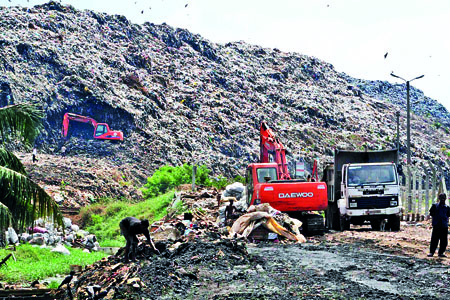
Our current growth model is run on consumption, and wellbeing is heavily reliant on material things. We do not worry too much about what we spew out as waste into the environment. This mode of operating is a crucial factor driving climate change as we are emitting more waste than the environment can absorb. Eventually this will come back to bite us. As is the case with most things related to climate change, it can also affect those who had the least to do with the problem.
Hence a new way of thinking or bringing back an old concept of growing within our means is needed. This requires thinking of the production cycle like a closed system (circular economy), where natural resources are used and reused to the maximum and what needs to be managed as waste is minimised. Some companies have proactively sought to adopt these approaches but such practices are yet to be fully embraced in our society. Other ideas that are slowly emerging are for consumers to rent or lease products and give it back to be ‘transformed’ into new products. Thus, cutting out waste and also reorienting the idea of ownership.
Garbage also has external costs such as illnesses and increased cost of living but also infringes on the rights of people to live in a clean and healthy environment. These are also the reasons why we need to go that extra mile and reflect on our own consumption patterns. So in our quest for more affluence, a more conscious effort is needed to guide us on what we throw away.
The fundamental for waste management from a consumer end is separation of garbage but also minimization of garbage. It is not as if we have to learn or be taught about minimising waste from scratch. Traditionally, people would recycle – from glass bottles to jam jars to used clothes and kitchen waste. We are also seeing so many more creative ways in which waste from one source can be “upclycled” or converted into something else. It will not happen overnight and much effort is needed – but it is also in our best interest for a healthier life. Hence, in this post-Meethotamulla debate about waste management, while we badly need better waste management services, it is also important to rethink what we consider waste and to put more emphasis on the individual’s responsibility towards minimising waste.
This would be the citizen’s contribution to wellbeing.
Source – 28/05/2017, The Sunday Times, See more at – http://www.sundaytimes.lk/170528/business-times/waste-and-affluence-more-money-more-garbage-242361.html

Roadkill leads to discovery of burrowing snake
A new burrowing snake was added to the list of species endemic to Sri Lanka when International Day of Biological Diversity was marked on Monday, strengthening the country’s image as a biodiversity hotspot.

A new non-venomous ‘shield tailed snake’ that lives under the soil was discovered from the Badulla District. The scientific paper describing this new species appeared in prestigious scientific journal ZooTaxa.
The new species is yet another discovery by veteran herpetologist Mendis Wickremasinghe, who recalls that he first saw the snake as a single roadkill specimen in 1999 in Beragala. Later, during an island-wide herpetology survey, Mr Wickremasinghe decided to search the area.
 The researchers dug randomly selected locations that are habitats for such species. They got lucky and found a snake hidden under the soil layer of a banana plant of a home garden in 2010. The snake was found about 15 centimetres deep and had a highly-modified head, bearing a blade-like rostral scale for burrowing.
The researchers dug randomly selected locations that are habitats for such species. They got lucky and found a snake hidden under the soil layer of a banana plant of a home garden in 2010. The snake was found about 15 centimetres deep and had a highly-modified head, bearing a blade-like rostral scale for burrowing.
Mr. Wickremasinghe said about 30 individuals could be observed during subsequent visits to the same locations. More such snakes were observed from the same locality and in suburban areas like Haldummulla with some of them seen moving above ground at night.
With the new discovery, this rhinophis genus now has 20 such snake species with 16 of them found in Sri Lanka that are endemic to the country. The other four snakes are endemic to India. Three of these Sri Lankan species have been recently described in 2009 and 2011. Mr Wickremasinghe said there could be more snake species that belongs to this group, emphasising need for more studies.
Dulan Ranga Vidanapathirana and Gehan Rajeev too assisted in this new finding. Mr Wickremasinghe also thanked the principal sponsors, Dilmah Conservation.
Source – 28/05/2017,The Sunday Times, Read more at – http://www.sundaytimes.lk/170528/news/roadkill-leads-to-discovery-of-burrowing-snake-242678.html

Sinharaja elephant attacks raise villager fury
The recent photograph that shows an elephant in musth
By Malaka Rodrigo
Sri Lanka’s biodiversity hotspot, Sinharaja, is home to two elephants – but pressure is mounting to translocate them after one killed two villagers. Last week, some angry villagers demanded the elephants be removed as a man and a woman were killed in Cypresswatte village.
The incident happened on May 16. The woman was killed at about 6:45 p.m., while the man was fatally attacked around 8 p.m.
A few days earlier, on May 13, the same elephant attacked a Wildlife Department jeep when the vehicle was involved in chasing the animal back into the forest. This incident was near Kudawa, Weddagala around 8.30 p.m. The panicked animal turned back and crushed the bonnet of the vehicle, slightly injuring those inside.
The elephant had been seen at other locations. It had paced around the tower on top of the Gongala Mountain. A photo taken at Gongala shows the elephant is in musth, which is the periodical rise of reproductive hormones of a bull elephant. At such times the animals are irritable and aggressive.
According to DWC records, the two Sinharaja elephants are responsible for 16 human deaths in villages such as Kopi-kella, Manikkawatte and Cypresswatte. Tea cultivations block their natural passages, forcing them to sometimes wander into populated areas.
Madura De Silva, the president of the Wildlife Conservation Society of Galle, said that there were three elephants sometimes back – one female and two males. The society setup camera traps as a part of a project related to leopards and the cameras captured the movements of an elephant. With the data they mapped its range.
DWC director general, W S K Pathiratne, said a decision had not been taken yet to translocate the killer elephant. More wildlife officers will be sent to the are.
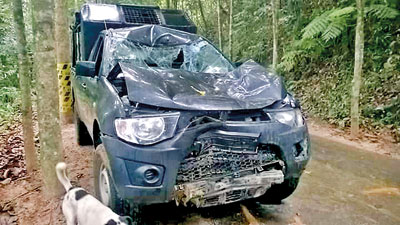 When asked if a radio collar could be fitted to track the animal, he said trapping the elephant would be challenging in the difficult terrain.
When asked if a radio collar could be fitted to track the animal, he said trapping the elephant would be challenging in the difficult terrain.
The elephant was in fact caught in 1999 by a team led by Dr Nandana Atapattu – a veterinary surgeon who was also a deputy director of DWC then. It took a team of 20 and a week-long effort. But villagers at the time, particularly the students of Kajuwatta School protested against removing the elephant saying it was an asset to the area. Dr Atapattu released the elephant.
At that time, there were records that the elephant charged but did not kill anyone.Environmentalist Jayantha Wijesinghe said these elephants roamed widely around Sinharaja, but attacked people only in some places. “The reason being that the villagers in these areas have harmed the duo, so the elephants become more aggressive,” he said.
The president of the Wildlife Conservation Society of Galle, Mr De Silva, said that in many areas, the local villagers understand the elephant’s movements and that helps to avert a potential disaster. He also said that because of the elephants, illegal activities such as felling trees for ‘walla patta’ and gem mining has been under control. “These elephants are the jewels of Sinharaja. it is better to let them be.”
The Sinharaja rainforest is a UNESCO World Heritage Man and Biosphere Site.
Source – 28/05/2017, The Sunday Times , Read More at – http://www.sundaytimes.lk/170528/news/sinharaja-elephant-attacks-raise-villager-fury-242684.html


